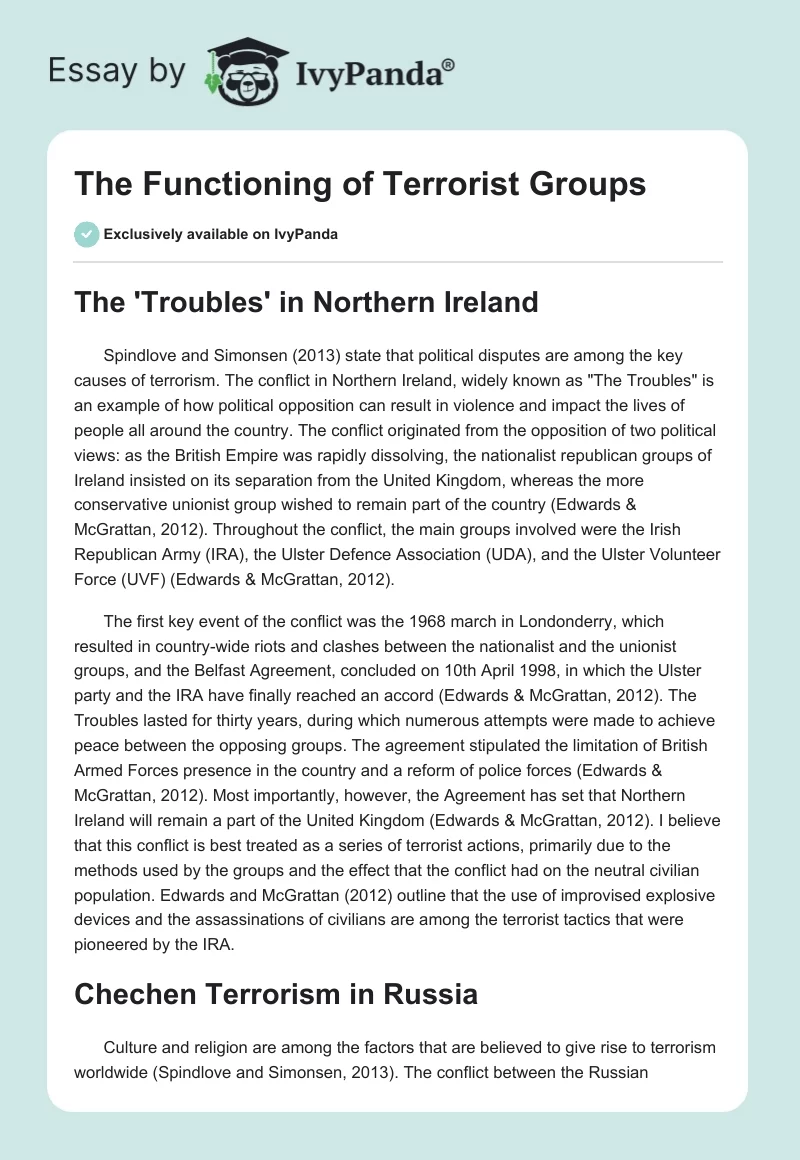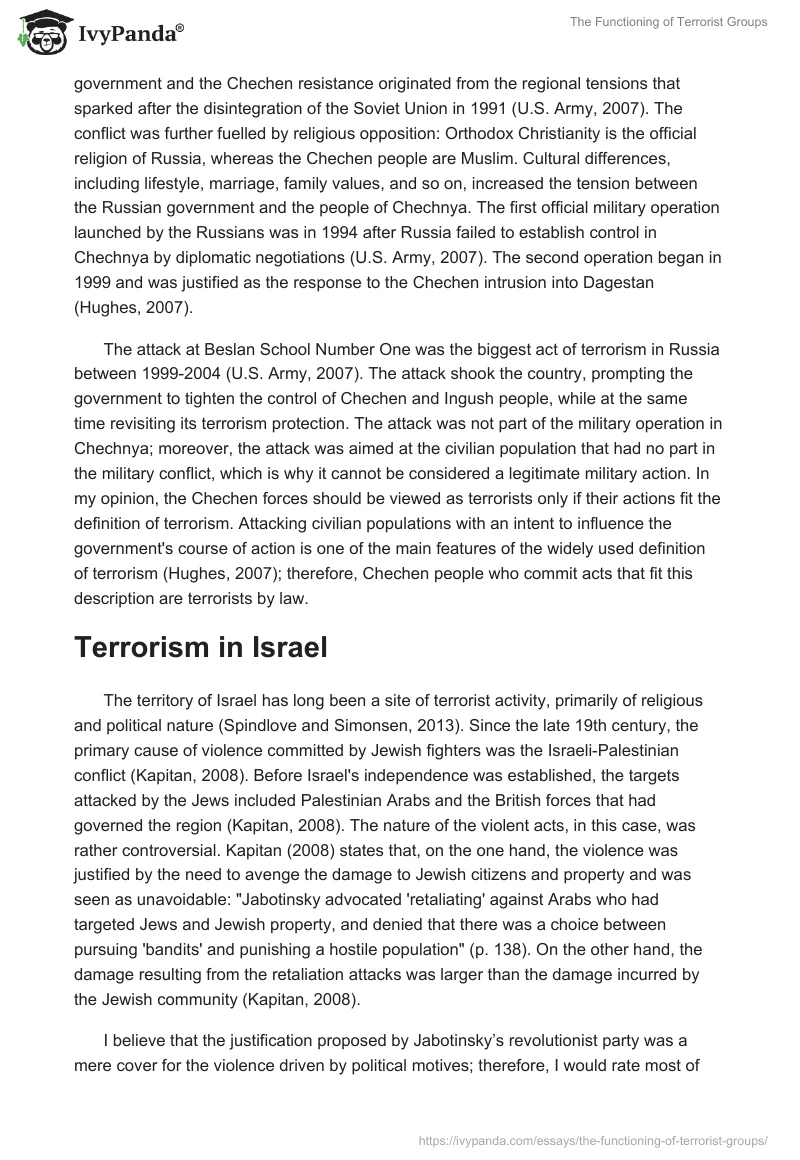The ‘Troubles’ in Northern Ireland
Spindlove and Simonsen (2013) state that political disputes are among the key causes of terrorism. The conflict in Northern Ireland, widely known as “The Troubles” is an example of how political opposition can result in violence and impact the lives of people all around the country. The conflict originated from the opposition of two political views: as the British Empire was rapidly dissolving, the nationalist republican groups of Ireland insisted on its separation from the United Kingdom, whereas the more conservative unionist group wished to remain part of the country (Edwards & McGrattan, 2012). Throughout the conflict, the main groups involved were the Irish Republican Army (IRA), the Ulster Defence Association (UDA), and the Ulster Volunteer Force (UVF) (Edwards & McGrattan, 2012).
The first key event of the conflict was the 1968 march in Londonderry, which resulted in country-wide riots and clashes between the nationalist and the unionist groups, and the Belfast Agreement, concluded on 10th April 1998, in which the Ulster party and the IRA have finally reached an accord (Edwards & McGrattan, 2012). The Troubles lasted for thirty years, during which numerous attempts were made to achieve peace between the opposing groups. The agreement stipulated the limitation of British Armed Forces presence in the country and a reform of police forces (Edwards & McGrattan, 2012). Most importantly, however, the Agreement has set that Northern Ireland will remain a part of the United Kingdom (Edwards & McGrattan, 2012). I believe that this conflict is best treated as a series of terrorist actions, primarily due to the methods used by the groups and the effect that the conflict had on the neutral civilian population. Edwards and McGrattan (2012) outline that the use of improvised explosive devices and the assassinations of civilians are among the terrorist tactics that were pioneered by the IRA.
Chechen Terrorism in Russia
Culture and religion are among the factors that are believed to give rise to terrorism worldwide (Spindlove and Simonsen, 2013). The conflict between the Russian government and the Chechen resistance originated from the regional tensions that sparked after the disintegration of the Soviet Union in 1991 (U.S. Army, 2007). The conflict was further fuelled by religious opposition: Orthodox Christianity is the official religion of Russia, whereas the Chechen people are Muslim. Cultural differences, including lifestyle, marriage, family values, and so on, increased the tension between the Russian government and the people of Chechnya. The first official military operation launched by the Russians was in 1994 after Russia failed to establish control in Chechnya by diplomatic negotiations (U.S. Army, 2007). The second operation began in 1999 and was justified as the response to the Chechen intrusion into Dagestan (Hughes, 2007).
The attack at Beslan School Number One was the biggest act of terrorism in Russia between 1999-2004 (U.S. Army, 2007). The attack shook the country, prompting the government to tighten the control of Chechen and Ingush people, while at the same time revisiting its terrorism protection. The attack was not part of the military operation in Chechnya; moreover, the attack was aimed at the civilian population that had no part in the military conflict, which is why it cannot be considered a legitimate military action. In my opinion, the Chechen forces should be viewed as terrorists only if their actions fit the definition of terrorism. Attacking civilian populations with an intent to influence the government’s course of action is one of the main features of the widely used definition of terrorism (Hughes, 2007); therefore, Chechen people who commit acts that fit this description are terrorists by law.
Terrorism in Israel
The territory of Israel has long been a site of terrorist activity, primarily of religious and political nature (Spindlove and Simonsen, 2013). Since the late 19th century, the primary cause of violence committed by Jewish fighters was the Israeli-Palestinian conflict (Kapitan, 2008). Before Israel’s independence was established, the targets attacked by the Jews included Palestinian Arabs and the British forces that had governed the region (Kapitan, 2008). The nature of the violent acts, in this case, was rather controversial. Kapitan (2008) states that, on the one hand, the violence was justified by the need to avenge the damage to Jewish citizens and property and was seen as unavoidable: “Jabotinsky advocated ‘retaliating’ against Arabs who had targeted Jews and Jewish property, and denied that there was a choice between pursuing ‘bandits’ and punishing a hostile population” (p. 138). On the other hand, the damage resulting from the retaliation attacks was larger than the damage incurred by the Jewish community (Kapitan, 2008).
I believe that the justification proposed by Jabotinsky’s revolutionist party was a mere cover for the violence driven by political motives; therefore, I would rate most of the attacks performed by Jewish fighters as acts of terrorism rather than self-defense. Kapitan (2008) classifies the violence in West Bank and Gaza Strip as state-terrorism, and I agree with this view. Similarly to the case of pre-independence attacks, the occupation of the West Bank and Gaza Strip was justified by appropriate reasons, such as the elimination of the terrorist infrastructure of the Palestinians (Kapitan, 2008). The underlying reasons, however, were mainly territorial and political: by weakening the presence of radical Palestinian groups in the area, the Jewish fighters could obtain more land and access to resources (Kapitan, 2008). Moreover, the acts committed in the region fit into the generally accepted definition of terrorism, as the primary targets of violence were civilians, who lost their lands, homes, and lives during the occupation (Kapitan, 2008).
Islamic Extremists in the Middle East
Spindlove and Simonsen (2013) state that Islamic extremist groups pose a major terrorist threat to the countries of the Middle East and their citizens. These groups pursue a variety of religious and political goals and commit significant acts of violence as part of their strategy. Lately, one of the most prominent Islamic extremist groups was the Islamic State. Initially, the group stemmed from the previous leader in global jihadism, Al Qaeda (Gerges, 2016). However, there are many differences between the structures of ISIS and Al Qaeda. The ISIS notably entered the Middle East political scene by a military surge in Syria and Iraq in 2013-2014: “. The group’s prowess was confirmed by the seizure of al-Raqqa and Deir al-Zour provinces in Syria in 2014 and the expeditious collapse of four Iraqi divisions overnight in Mosul and elsewhere in northern Iraq under the determined assault of outnumbered fighters in summer 2014” (Gerges, 2016, p. 2).
The local governments had little power to counter the attacks on civilian population and the seizure of lands, which prompted the introduction of international military forces into the political scene of the affected countries. The group is motivated by religious and territorial reasons: the main goal of the organization is to establish a unified Islamic rule, or a caliphate, across the territories of Iraq, Syria, and other Middle Eastern Countries (Gerges, 2016). In my opinion, the goal is too unrealistic to be a real strategic motivation of the group. One strategic goal that the ISIS can achieve, however, is establishing control in parts of the Middle East that give access to oil resources: oil mining, as well as the taxation of the people living in controlled regions, are the main sources of financing for the ISIS (Gerges, 2016).
State Terrorism in Latin America
Although not as widespread today, state terrorism was a major issue in Latin America in the second half of the 20th century (Spindlove and Simonsen, 2013). The two countries that were particularly affected by this form of terrorism were Argentina and Chile. Blanche (2003) argues that one of the main reasons for the spreading of terrorism in Latin America was the government’s weakness in controlling the population. Wright (2007) explains that the main goal of the attacks was to scare the population into obedience and loyalty to the government, which is why they are classified as acts of state terrorism. There were two main reasons as to why many residents viewed these forms of government control as acceptable. First, the protection of human rights requires set standards to enable people to classify certain events as the violation of their rights.
However, as Wright (2007) outlines, the concept of human rights was virtually non-existent in the post-war Latin America. There were little regulations regarding the actions of the state government, the police, and the armed forces against the civilians, which gave more freedom to these structures, while at the same time exempting them from being liable for the damage caused. Another significant factor was the widespread state propaganda. After the World War II, people were afraid for their safety, and when the officials told them that certain groups or individuals posed a threat, the violence was seen as a necessary measure to prevent the danger (Wirght, 2007). Personally, I doubt that state terrorism could emerge within the United States, primarily because of the current preoccupation with the protection of human rights nationwide. Furthermore, there are no significant internal threats to the government of the U.S. at the moment, which is why state-sponsored violence is not required.
Latin America and Islamic Jihad
The Tri-Border Region, including Paraguay, Argentina, and Brazil was the major site of jihadist activity in the Latin American region (Spindlove and Simonsen, 2013). The significance of the area to terrorist organizations lies in several factors. First, as Blanche (2003) states, “the governments of three countries seem incapable of imposing any sort of order [in the region]” (p. 28). This gives more freedom for terrorist organizations not only to perform attacks but also to engage in money laundering, drug selling, and smuggling, which are among the main sources of income for terrorist groups (Blanche, 2003). Another reason is the corruption of the local governments, which also allows terrorist groups to execute their activities under little control (Blanche, 2003).
Finally, the region’s central location has made it a center of military communication, which is useful for associated terrorist groups (Blanche, 2003). Hizbullah is considered to be the most active terrorist group in the region (Blanche, 2003). According to Blanche (2003), neither of the governments made solid attempts to control the terrorist activity in the area. For the most part, their efforts involved gathering intelligence and monitoring the flow of contraband and drugs between the countries with intent to limit the income of the terrorist groups (Blanche, 2003). The U.S. has also been providing economic and military aid to the governments. In 2005, the country first deployed troops to assist the law enforcement and the army of Paraguay. The main effect of the U.S. military aid was the increased support of local governments in controlling the terrorist groups. The cooperative efforts were somewhat effective in limiting the flow of drugs and weapons, as well as the financing of terrorists, which affected the functioning of terrorist groups in the area.
References
Blanche, E. (2003). Al Qaeda: The Latin American connection. Middle East, 334(1), 28-31.
Gerges, F. A. (2016). ISIS: A history. Princeton, NJ: Princeton University Press.
Edwards, A., & McGrattan, C. (2012). The Northern Ireland conflict: A beginner’s guide. Oxford, UK: Oneworld Publications.
Hughes, J. (2007). The Chechnya conflict: Freedom fighters or terrorists? Demokratizatsiya, 15(3), 293-311.
Kapitan, T. (2008). Terrorism. In R. Halwani & T. Kapitan (Eds.), The Israeli-Palestinian Conflict (pp. 132-197). Basingstoke, UK: Palgrave Macmillan.
Spindlove, J. R., & Simonsen, C. E. (2013). Terrorism today: The past, the players, the future (5th ed.). Upper Saddle River, NJ: Pearson Education.
U.S. Army. (2007).Terror operations: Case studies in terrorism (TRADOC G2 Handbook No. 1.01). Web.
Wright, T. C. (2007). State terrorism in Latin America: Chile, Argentina, and international human rights. Lanham, MD: Rowman & Littlefield.


